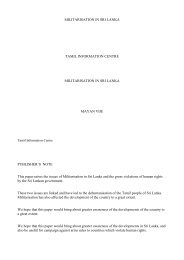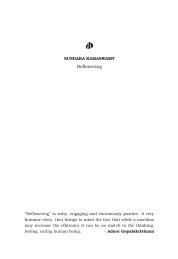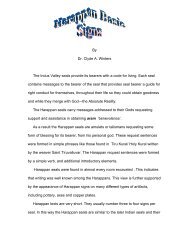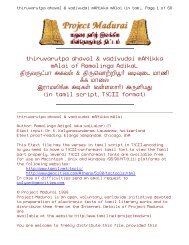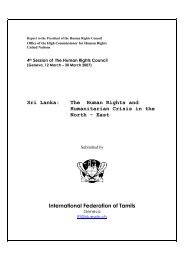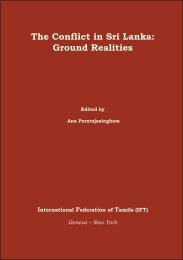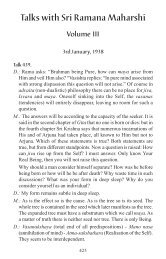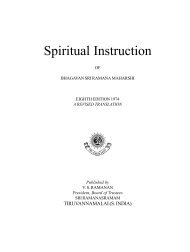Asymmetric Warfare And Low Intensity Maritime Operations
Asymmetric Warfare And Low Intensity Maritime Operations
Asymmetric Warfare And Low Intensity Maritime Operations
- No tags were found...
Create successful ePaper yourself
Turn your PDF publications into a flip-book with our unique Google optimized e-Paper software.
ORF Occasional Paper<strong>Asymmetric</strong> <strong>Warfare</strong> <strong>And</strong> LIMO: Challenges For Indian Navyreminder that countries need to revitalize national fleets and challenge FOC vessels.If the maritime community is serious about challenging the forces of terrorism, thenit must establish a framework for a genuine link between the flag a vessel flies and thestate it belongs to.CrewThough merchant ship crew are trained to handle emergencies onboard ships, they havebeen found wanting in professional competence. According to the International <strong>Maritime</strong>Bureau (IMB), it is virtually impossible to verify the authenticity of the identityof the crew. 47 Besides, there is a major problem of counterfeit and improperly issuedmariner documentation. IMB has issued a warning to ship operators about thousandsof unqualified crew and masters working illegally with false papers, and has called fortighter security by authorities issuing certificates.The alert follows the release of statistics showing that, of 54 maritime administrationssurveyed, more than 12,000 cases of forged certificates of competency were reported. 48These figures highlight the gravity of the situation. Ships are sailed by crewmen withfalse passports and competency certificates. The IMB also believes that at times the issuingauthorities themselves are to blame. For instance, the Coast Guard office in PuertoRico was reported to have issued nearly 500 suspicious certificates of competency. 49Such cases usually escape detection by the port authorities.At times, crews themselves can act as potential threat. Both the Philippines and Indonesiaare the largest suppliers of merchant ships. These states are home to radicalgroups like the Abu Sayyaf and the Gerakan Aceh Merdeka (GAM). 50 In December2002, a joint Indonesian navy-military patrol seized a barge manned by seven Indonesiancrewmen, some 10 km off the coast of East Aceh, northern Sumatra, Indonesia.The vessel was reportedly carrying explosives and detonators from Penang in Malaysiato Aceh. 51 A search of the barge yielded 46 detonators and 55 sticks of ‘power gel’, anexplosive material that is usually combined with other explosives. A month before, theIndonesian navy’s western fleet had destroyed two ships carrying smuggled arms forGAM. The separatists had seized the vessels from Thai fishermen to smuggle arms toAceh province. The action was taken after the rebels controlling the ships opened fire.The crew, who were held hostage by the rebels, had been freed.Earlier, in August 2001, a general cargo carrier, M V Ocean Silver, while transitingthrough the Malacca Strait, a piracy prone area, was captured by GAM rebels. The sixcrew members of the vessel were taken hostage. In an attempt to rescue the vessel andthe crew, the Indonesian security forces engaged in a gun battle with the insurgents, thatresulted in the death of a soldier and three rebel insurgents. But, the hostages could notbe rescued. What was more disturbing was the fact that the GAM issued a warning thatall ships transiting through the straits between Sumatra Island and Malaysia must firstget permission from the insurgents.It is virtually impossible to detect potentially undesirable crew members. The situationgets more complicated in case of vessels that fly ‘Flags Of Convenience’ and employmulti-national crews. It is difficult to verify the identity of the crew. Interestingly, theship itself is a safe den for undesirable elements. There are several hidden spaces, holdsand compartments in the ship that are difficult to inspect. Some spaces are so unfamiliarthat it may be difficult to locate them without the help of the ship’s compartment drawings.Modern-day tankers, bulk carriers and cargo vessels are very large and can easilycarry dangerous devices, substances and stowaways within.Drug SmugglingIt is well known that South East Asia along with South West Asia are the two top opiumand heroin producing regions in the world. Myanmar tops the list with an annual productionof more than 2,500 tonnes. Heroin produced by Myanmar is largely traffickedthrough unmarked transit land routes and through sea routes. Traffickers move herointhrough Myanmar’s seaports such as Moulein for sea-borne passage to the west. The‘Golden Triangle’ and the ‘Golden Crescent’ surround India. By virtue of its geographiclocation, India has emerged as an important transit route for drugs.Sri Lankan port of Jaffna is home to Tamil pirates and drug dealers. They providesecurity and courier for Myanmar drug shipments. Importantly, they have developedan integrated network of drug production and shipment by the sea route. Bulk quantitiesare transported over the seas to mainland US and Europe. Reports also suggest that‘ganja’ cultivation is being resorted to by some Acehnese in the remote areas of Aceh inIndonesia. If the “Free Aceh” rebellion catches on, drug cultivation and drug runningcould be used by them to finance their insurgency.‘Golden Crescent’, with its centre of gravity in Afghanistan is the other importantsource of opium. A large quantity of opium is routed overseas through land routes inPakistan to Karachi. Part of this consignment also find its way to India through landroutes along the India-Pakistan border as also through the sea routes to Gujarat. 52As part of Operation Enduring Freedom, a Canadian warship patrolling the ArabianSea seized a wooden vessel carrying hashish off the coast of Pakistan. 53 The Canadianboarding party found 20 packages of the size of cement blocks (wrapped in blue plasticand stamped with ‘Freedom for Afghanistan’). The vessel was towed into internationalwaters and destroyed using heavy machine guns. It is believed that drug trafficking profitshave been used to finance Al Qaeda.15www.orfonline.orgwww.orfonline.org 16



